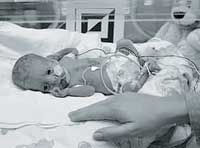Heart surgery patient is smallest yet
 |
|
Serena Brown, the day she was released from Packard. At the time of surgery, her heart was the size of the tip of her surgeon’s thumb. |
|
By Camille Mojica Rey
Serena Brown weighed about as much as two cans of soda when she and two sisters were born on Dec. 27, 2001 — nearly four months early. She became the smallest and youngest infant ever to undergo open-heart surgery and, in February, was well enough to be released from Lucile Packard Children’s Hospital to a hospital closer to her family in Sacramento.
Serena was born with a heart defect that would have been fatal if not surgically repaired. Doctors had hoped she would overcome the obstacles related to her premature birth long enough so that she would grow even a little, reducing the risks of surgery. But, as her condition worsened, her doctors decided to move forward with the technically difficult surgery.
"Her chest was smaller than my palm, and her heart was the size of the tip of my thumb," says V. Mohan Reddy, MD, chief of pediatric cardiac surgery at Packard, who led the team that performed the operation.
On Jan. 11, when Serena underwent surgery, she weighed only 640 grams, or 1.4 pounds, which is about one-fifth of normal for a newborn. "Most surgeons don’t do this operation on a patient under 1,000 grams," Reddy adds.
After reviewing the field’s literature and conferring with his colleagues across the country, Reddy concluded that Serena is the youngest baby ever to have open-heart surgery, and the smallest.
Serena suffered from a condition called total anomalous pulmonary venous return, in which the veins connecting her lungs to her heart were attached to the wrong side of the heart. This meant that oxygen-rich blood from her lungs was not circulating efficiently to the rest of her body.
The only thing keeping Serena alive was a naturally occurring hole between the two halves of the heart. Normally, that hole seals itself soon after birth. To correct the condition, Reddy re-attached the veins to the correct side of the heart and closed the hole.
Upon leaving Packard, Serena joined her twin sister, Brianna, at Sutter Medical Center in Sacramento. As of mid-May, Serena was in good condition after contracting what doctors believed to be a viral infection in April.
The third sister, Jocelyn, died of necrotizing enterocolitis, an inflammation of the intestines common in premature infants. "It was hard to lose one. I was really attached to her," Serena’s mother Lori Brown says.
The Browns say they have coped with this emotionally and financially difficult time through the help of family, friends, nurses and doctors and by drawing strength from their 20-month-old son Dylan. Serena’s progress, her mother adds, has been inspiring. "I am not a religious person, but lately I have been praying a lot, she says."
Comments? Contact Stanford Medicine at

